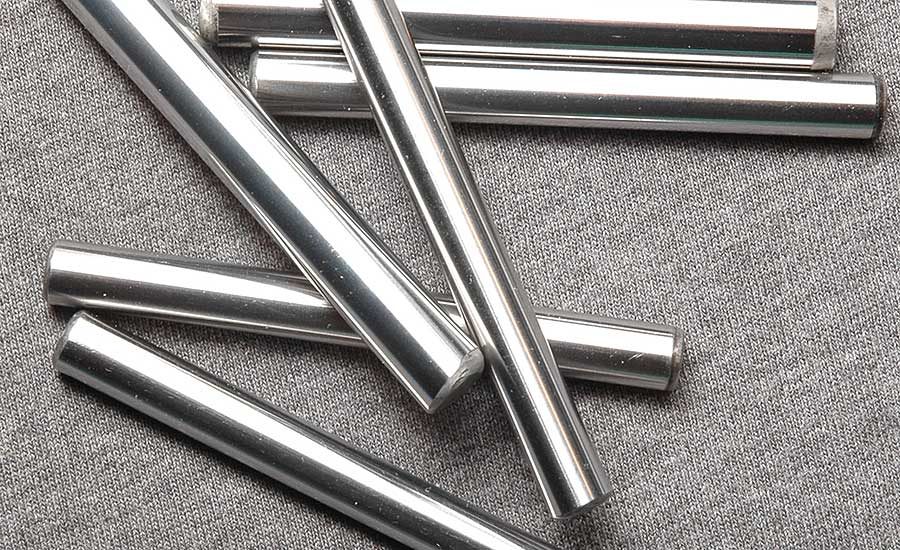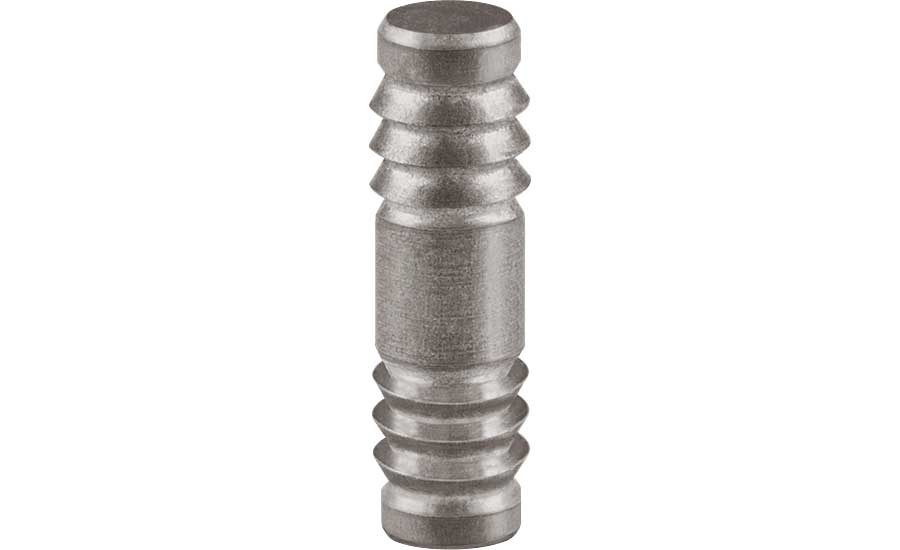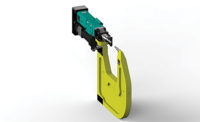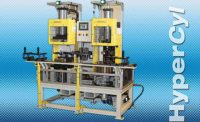In the classic game Pin the Tail on the Donkey, players use a push pin to attach the tail to the donkey. On a metal or plastic toy donkey, however, a push pin would be unable to hold the tail in place, especially if it needs to move in some way. A better choice for this application is a solid metal dowel pin.
“Dowel pins are widely used for alignment, but can also work great as a bearing surface for rotation,” explains Mike Apsey, director of product engineering and development at Driv-Lok Inc. “Another benefit is they can be removed and replaced by the end-user without distortion.”
Driv-Lok has been making dowel pins since the early 1960s and groove pins since 1941. The latter pin type features three grooves equidistant around the circumference.
A few years ago, a Tier 1 automotive supplier of actuators needed a fastener to secure a small plastic shroud to an actuator’s protective aluminum housing. The fastener also had to ensure connectivity in all weather conditions and prevent actuator rotation.
Driv-Lok’s Enginomics team developed a miniature Type-U grooved pin that is pressed into the housing through the shroud in three spots. The pins prevent any movement by the shroud and actuator, while ensuring connectivity. In addition, the pins are automatically bowl fed into the press to lower installation costs, according to Apsey.
Groove and dowel pins are but two of many that manufacturers use to assemble parts as diverse as vehicle engines, compressor pistons and makeup powder compacts. Equally important to manufacturers are metal dowels, which ensure proper alignment of mating components with minimum hole preparation.
Both the pins and dowels are cost-effective, install easily and have a decades-long record of success. No wonder they are increasingly popular among manufacturers in a wide range of industries, most notably automotive, medical devices and recreation.
Extensive Selection
Many types of pins are used for assembly, and are categorized as either solid or hollow, with a symmetric or an asymmetric shape. Solid symmetric pins include dowel, grooved, knurled, barbed and ferrol. Flat- and round-headed versions of these pins, also known as studs, are considered asymmetric.
Hollow symmetric pins are slotted and coiled spring. All dowels are hollow symmetric with either a split or seamless body.
Pins and dowels measure from 0.03125 to 1.5 inches in diameter and up to 6 inches in length. They are most commonly made of low-carbon or stainless steel, various alloys, aluminum, brass or titanium. Finishes include passivated, nonpassivated and black oxide.
The dowel pin is a smooth cylinder of metal, although it may be chamfered at each end to aid insertion. This pin is typically hardened and manufactured to precise fractional diameters and lengths, and used as a hinge, shaft or pivot to locate or hold parts together.
The dowel pin withstands the most shear force of any fastening pin. It is preferred for high-production assembly because it requires no extra fastening hardware for insertion or secondary operations.
The grooves of a grooved pin are formed by a swaging operation in which three tools penetrate the nominal diameter of the pin metal at 120-degree intervals, according to Apsey. This penetration displaces a controlled amount of metal to each side of the grooving tool, forming a raised portion along the side of each groove.
“This type of pin is great for permanent joints or those that require pivoting or rotation, as well as for part location,” says Apsey. “Many manufacturers prefer using groove pins to screws in assemblies that are regularly exposed to high vibration.”
Knurled pins are available with either straight, helical or diamond-configured knurls. Unlike a straight dowel pin, where retention is provided by the uniform interference between the pin and hole, knurled pins are designed to cut into the host components, notes Christie Jones, director of marketing and vice president at SPIROL International Corp. However, neither knurled nor grooved pins require the tight tolerances needed by precision solid dowel pins.
“The displacement of the host material into the valleys of the knurls yields more frictional contact area between the pin and hole, thus resulting in higher retention,” says Jones. “With our helical knurled pins, a 30-degree knurl causes the pin to rotate as it enters the hole, creating even more surface contact with the host. This results in higher frictional forces, greater engagement and improved resistance to backing out.”
Apsey says that Driv-Lok’s diamond-configured knurls can be made at certain spots on the pin or all over the pin. He says the diamond shape provides greater axial retention force to prevent pullout than straight or helical knurls, and that some customers select the diamond configuration simply because of the way it looks.
Designed for use in plastic and soft metal, depending on the pin for the latter material, barbed pins have external raised barbs that are angled backwards or opposite the direction of insertion. As the pin is being inserted, the host material backfills into the area around the barbs, resulting in maximum resistance to axial force and a secure, tamper-resistant assembly.
SPIROL introduced its Press-N-Lok barbed pin last fall. According to Jones, the pin has opposing barbs on each end that permanently retain two plastic components to each other. The key limitation of the pin is it is not appropriate for brittle plastics or those containing a high percentage of glass fillers.
Computer, Shelving
A large lead-in ensures alignment with the hole and eases installation, which is a two-step process. After pins are installed into the lower half of the assembly, a press is used to fasten the other mating half.
“A ferrol pin is similar to a barbed one in that it also provides positive fastening and is a cost-effective alternative to conventional screws and barbed nails,” explains Apsey. “The difference is the ferrol pin has a ribbed ring all the way around and up and the down its shaft. Material fully flows around this ring and creates a tight fit.”
One major manufacturer of infant car seats uses a Drive-Lok ferrol stud to hold in place the armrest at each side of a specific plastic seat. The armrests rotate freely while maintaining the required tight fit, yet pin removal is virtually impossible. Apsey says that, previously, a standard screw was used to fasten each armrest. However, up and down movement eventually loosened the screws.
The coiled spring pin consists of a 2-1/4 helical wrap of carbon, stainless or alloy steel. Its outer diameter ranges from 0.03125 to 0.75 inch, and its standard length is usually no more than 6 inches. The pin’s outer diameter is slightly larger than the hole diameter to ensure retention, notes Mike Pasko, an application engineer at SPIROL.
When correctly sized and installed, the pin offers a minimum of 270 degrees of radial contact in the hole. Another benefit is the ability to resist shock and vibration. This isolates the hole material from the forces, and contributes to the prolonged useful life of the assembly.
Slotted spring pins are economical, shear-type fasteners that are self locking. Apsey says their oversize dimension exerts radial forces upon insertion to firmly hold the pins in place. Common uses include being spacers, stop points and hinges in thousands of demanding, but nonprecision, industrial applications.
Hollow dowels simplify assembly by easing fastener insertion. They also maintain precise alignment within hole tolerances.
Dowel bushings from SPIROL permit a fastening screw or bolt to pass through the inside diameter after installation. The company’s ground hollow dowels can directly replace standard ground solid dowels (per ISO 8734), and be used where centerline tolerancing and precision alignment are required. Spring dowels are formed around arbors to ensure roundness, while accurately locating components next to each other.
Apsey says that Driv-Lok split hollow dowels save its manufacturer customers from 30 to 40 percent—compared to traditional dowel pins—in production, weight and labor costs by eliminating hole reaming and finishing. The dowels are used as spacers, compression limiters or where two halves of an assembly are bolted together.
Also available from the company are seamless hollow dowels for applications where a seam is not allowed or desired. These dowels can be used as locators, spacers or a standoff, and are available in various materials and finishes, as well as being heat treated.
Straightforward Installation
“For pins and dowels, press-fit is the standard installation method,” says Chuck Rupprecht, general manager at BalTec Corp. “Installation may be permanent or temporary, and is a simple process that is typically done with a benchtop manual, pneumatic or hydraulic press. Automated pressing is done as well, although in that situation you need to have an extremely high volume for a reasonable ROI.”
Straight-acting presses are preferred over toggle presses. The amount of force required to press parts together depends on the hardness, slipperiness and surface finish of the materials; the size, thickness and geometry of the parts; and the amount of interference between them, that is, the difference in size between the inserted part and the hole.
As a general rule, solid pins should be 0.0002 inch wider than the nominal hole diameter. For example, a 0.25-inch-diameter standard hole will receive a dowel having a diameter between 0.2501 and 0.2503. Oversized pins are usually used to fit into worn holes (for pin replacement) and have a diameter that is 0.001 inch wider than the nominal diameter.
Straight solid pins tend to have the tightest hole tolerances when being inserted into metal, says Jones. With a hardened grooved or knurled pin, the host material deforms, but not as much as with a straight solid pin. When any of these pins are used in plastic, the holes are molded and the plastic is more forgiving.
Precision solid dowels require a precisely drilled and reamed hole prior to being press-fit into place. In contrast, holes for coiled spring and slotted pins only have to be drilled, resulting in lower preparation costs, says Jones. When driven into a hole, the latter pins’ spring action lets them compress and assume the hole diameter.
According to Rupprecht, pins that require less than 4 kilonewtons of force can be installed with a manual press. This type of press usually has an anti-lock mechanism to ensure proper pin insertion. The mechanism requires the operator to fully complete pin insertion before the press ram comes to a hard stop.
Pins that require 4 or more kilonewtons of force for insertion should be installed with a pneumatic or hydraulic press. Rupprecht points out that, although more expensive upfront, these presses allow for press monitoring of the force-distance curve.
The DA series of direct-acting pneumatic presses from BalTec are modular and can be exactly sized for any pin- or dowel-insertion application. Standard stroke lengths range from 40 to 120 millimeters in 20-millimeter increments, although special lengths may be requested. The presses utilize two-handed control, produce a constant force over the whole stroke length and can be integrated with the company’s IPC controllers for individual workstations. A right-angled gearbox allows for simple height adjustment of the press head. The presses are quiet (less than 75 decibels) and practically maintenance-free, as all moving parts are mounted in bearings.
“Coiled spring pins have several features that contribute to trouble-free automation,” says Jones. “They never nest or interlock because they have no slots. And their square, clean-cut ends, combined with a smooth, concentric lead-in chamfer and a blended radius, eliminate sharp edges and angles that may bite into the hole wall, thus lowering the required insertion force.”
Slotted pins, unless of verified high-quality manufacture, should never be automatically installed, as many do not have either quality chamfers or square ends. When entering the machine’s escapement area, this pin’s uneven end tends to catch on the pin above it in the feed tube and prevent advancement. The pin’s slot can also jam the machine’s pin insertion mechanism.
Symmetric pins have a continuous profile and are ideal for automated insertion, says Pasko. They are the easiest to feed because they require little, if any, orientation. All that’s needed is a machine that delivers parts in a straight line to the feed tube, then moves them down to some type of insertion equipment.
Automated insertion of asymmetric pins is more challenging because they require end-to-end orientation via expensive tooling. According to Pasko, headed pins with inconsistent head diameters or shafts tend to get jammed on the feed rail. Flat-headed pins are better than round-headed ones for automation, as it’s easier to press a flat insertion tool onto a flat surface while keeping the fastener straight.
“Hollow dowels require about half as much force as pins for proper insertion,” notes Rupprecht. “This guideline applies to the metal or plastic material that the dowel blocks or retains after insertion.”
He says that installation may be done with a press or by tapping the dowel in place with a hammer or mallet. Some dowels can be automatically inserted as well.









